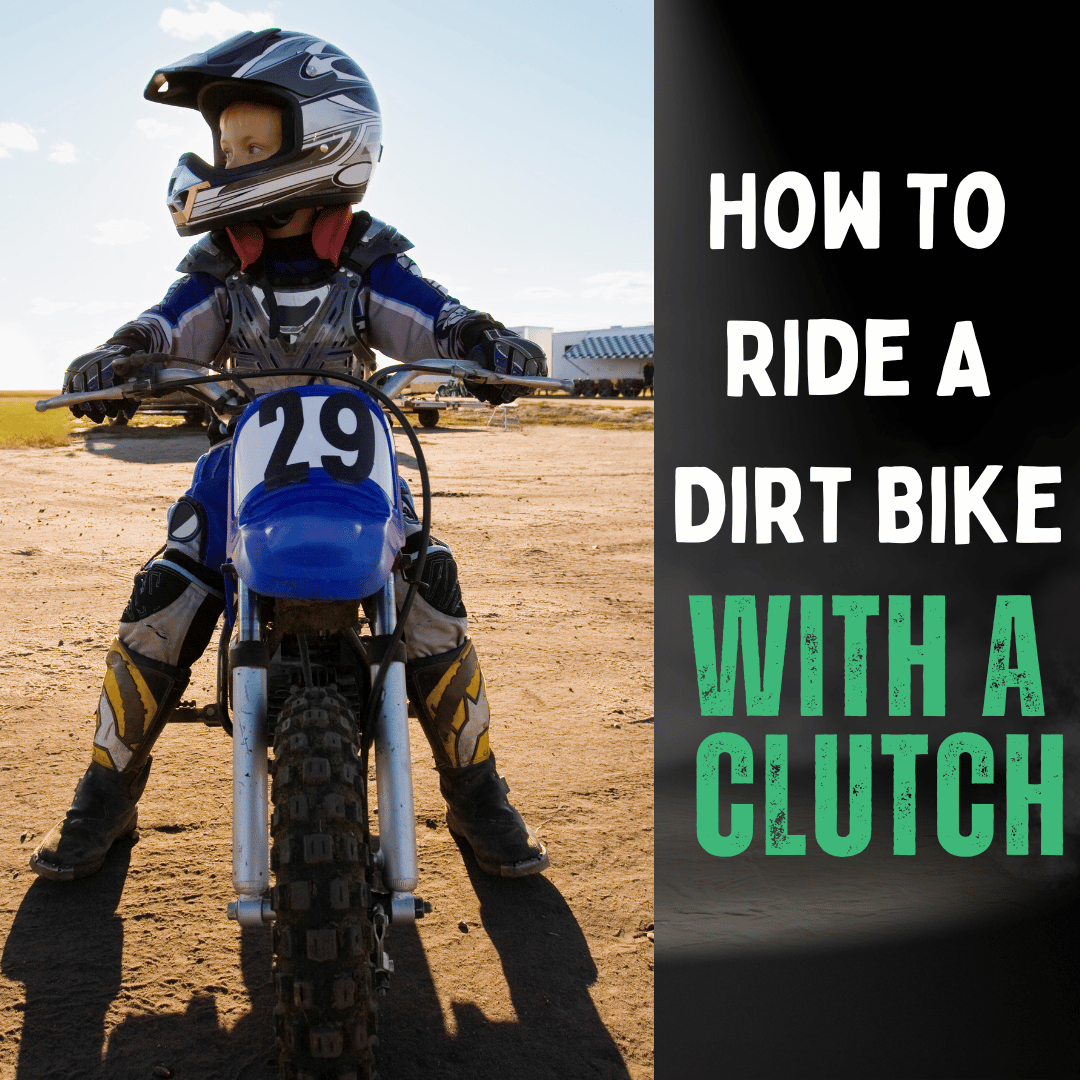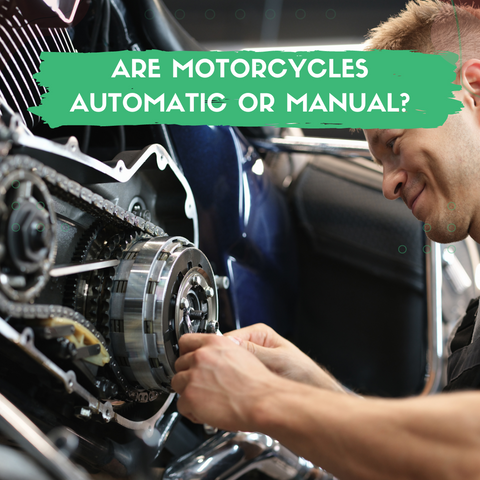
Published: 16.8.23
Updated: 19.7.24
Congratulations on taking your first step into the thrilling world of dirt biking!
Riding a dirt bike can be an exhilarating experience, but it can also be a little challenging if you’re not familiar with how to use a clutch.
In this beginner's guide, we'll walk you through the process step by step, ensuring you have a smooth and safe ride.
And remember, practice makes perfect!
Step 1: Gather Your Gear
Before you start your dirt bike, make sure you're equipped with the necessary safety gear.
A helmet, gloves, and boots are essential to protect yourself from injuries.
Investing in quality gear is a wise decision as it offers better protection and lasts longer.
Comfort is key, so ensure your gear fits well and doesn't restrict your movement.
Step 2: Familiarise Yourself With Your Bike
Before you begin, familiarise yourself with the main components of your dirt bike.
You should know where the clutch lever, kick starter, shift lever, and throttle are located and understand their functions.
The clutch lever is found on the left handlebar and is used to engage or disengage the engine's power.
The kick starter is located on the right side of the bike and is used to start the engine.
The shift lever is operated by your left foot and is used to change gears.
The throttle is located on the right handlebar and controls the speed of your bike.
Key Dirt Bike Components
Clutch Lever
Located on the left handlebar, used to engage or disengage engine power.
Kick Starter
Found on the right side of the bike, used to start the engine.
Shift Lever
Operated by your left foot, used to change gears.
Throttle
Located on the right handlebar, controls the speed of your bike.
Step 3: Starting the Bike
Starting your bike requires a few simple steps. First, find neutral by gently moving the shift lever up or down until it clicks into place.
Release the clutch lever, then use the kick starter to start the engine.
Once the engine is running, pull in the clutch lever again.
Always let your bike warm up before riding. A cold engine can be damaged easily, so give it a minute or two to get up to temperature.
Step 4: Putting the Bike in Gear
With the clutch lever pulled in, use your left foot to push the shift lever down into first gear.
Be aware that not using the clutch when shifting can lead to damaged gears.
Related: How to Shift Gears on a Motorcycle Like a Pro
Step 5: Gently Accelerating
Now comes the exciting part – moving! Gradually twist the throttle while slowly releasing the clutch lever.
The clutch is sensitive, so it's important to find the balance between giving gas and releasing the clutch to avoid stalling or sudden acceleration.
Balancing and Posture
Balancing and maintaining the right posture is crucial when riding a dirt bike, especially when using the clutch.
When accelerating, ensure you are seated with your weight distributed evenly across the seat.
Keep your back straight, your head up, and your eyes on the path ahead.
Grip the handlebars firmly but not too tightly, and keep your elbows slightly bent.
Position your feet on the footpegs so that the balls of your feet are on the pegs. This allows you to quickly shift and brake when needed.
Proper balance and posture will give you more control over your bike and make your ride smoother.
Learning the right posture is an essential skill for every beginner rider.
Related: How to Install Dirt Bike Grips
Avoiding Stalling
Stalling happens when your engine cuts out, usually because of an imbalance between the clutch release and throttle.
It's a common occurrence for beginners but can be frustrating. To avoid stalling, make sure you're giving the bike enough throttle as you release the clutch.
It's a delicate balance, and finding the right amount of throttle for a smooth start takes practice. If you stall, don't worry! Just pull in the clutch, start the bike again, and try once more.
Remember, practice makes perfect.
This is a skill you'll learn as you continue your journey as a dirt bike rider.
Related: Are Motorcycles Automatic or Manual?
Maintaining Your Clutch
Taking care of your dirt bike's clutch is essential for a smooth riding experience and prolonging the life of your bike.
Here are some tips to help you maintain your clutch:
- Regularly Check the Clutch Cable: The clutch cable should be free of kinks, rust, and dirt. Lubricate it regularly to ensure smooth operation.
- Adjust the Clutch Lever: The clutch lever should have a little free play (about 2-3 mm). If it's too tight or too loose, it can affect the clutch's performance.
- Change the Oil: The clutch is bathed in oil, and dirty or old oil can affect its performance. Regular oil changes can help prevent clutch slippage and ensure smooth gear shifts.
- Avoid Riding the Clutch: Holding the clutch lever in while giving the bike gas, known as "riding the clutch," can cause premature wear. Use the clutch only when necessary.
- Inspect the Clutch Plates: If you're experiencing clutch slippage, it might be time to inspect the clutch plates for wear. Consult your bike's service manual for guidance on how to inspect and replace them.
Proper maintenance will not only prolong the life of your clutch but also enhance your riding experience.
Each of these new sections adds valuable information for readers who are learning to ride a dirt bike with a clutch.
They provide tips on balancing and posture, avoiding stalling, and maintaining the clutch - all essential aspects of a smooth and enjoyable riding experience.
Related: Do Pro Motocross Riders Use The Clutch?

Step 6: Shifting Gears
As you pick up speed, you'll need to shift gears. To do this, pull in the clutch lever and use the shift lever to change gears.
When navigating rough terrains, you may need to "slip the clutch", meaning you bring the clutch back to its engagement point while moving forward, allowing you to build revs for better control.
Related: Can You Ride A Motorcycle In The Rain?
Step 7: Practicing in a Safe Environment
Beginners should practice in open and safe areas like a flat dirt field or a designated dirt bike track.
Here, you can practice basic skills like starting, stopping, turning, and shifting gears without the pressure of traffic or obstacles.
Safe Practice Environment for Beginners
Open Field
Flat terrain with minimal obstacles
Safety Gear
Always wear helmet, gloves, and protective clothing
Start Slow
Begin with basic maneuvers at low speeds
Supervision
Practice with experienced riders nearby
Step 8: Seeking Professional Training
If you're serious about dirt biking, consider taking a course to learn proper techniques and safety practices.
Professional instruction can help you build confidence and improve your skills more rapidly.
Maintaining the Clutch
Taking care of your dirt bike's clutch is essential for a smooth riding experience and prolonging the life of your bike.
Here are some tips to help you maintain your clutch:
-
Regularly Check the Clutch Cable: The clutch cable should be free of kinks, rust, and dirt. Lubricate it regularly to ensure smooth operation.
-
Adjust the Clutch Lever: The clutch lever should have a little free play (about 2-3 mm). If it's too tight or too loose, it can affect the clutch's performance.
-
Change the Oil: The clutch is bathed in oil, and dirty or old oil can affect its performance. Regular oil changes can help prevent clutch slippage and ensure smooth gear shifts.
-
Avoid Riding the Clutch: Holding the clutch lever in while giving the bike gas, known as "riding the clutch," can cause premature wear. Use the clutch only when necessary.
-
Inspect the Clutch Plates: If you're experiencing clutch slippage, it might be time to inspect the clutch plates for wear. Consult your bike's service manual for guidance on how to inspect and replace them.
Proper maintenance will not only prolong the life of your clutch but also enhance your riding experience.
Conclusion
Learning to ride a dirt bike with a clutch can be a little challenging, but it’s well worth the effort.
The key is to practice regularly and in a safe environment.
Remember, safety first - always wear the right gear and consider professional training to get the most out of your dirt biking experience.
Enjoy the ride!
FAQs
How can beginners avoid common mistakes when using the clutch on a dirt bike?
Beginners often make the mistake of releasing the clutch too quickly, which can cause the bike to abruptly stop. To avoid this, it's important to keep the clutch in the "friction zone" where the engine and transmission start to engage. This zone allows the bike to build enough acceleration for a smooth release of the clutch. Practicing this gradual release in a controlled environment helps beginners develop proper clutch control and prevent sudden stops.
What are some tips for shifting gears on a dirt bike with a clutch for beginners?
Beginners can follow these tips for smooth gear shifting:
- Fully squeeze the clutch lever before shifting.
- Use the left foot to tap the gear shifter up or down to change gears.
- Release the clutch lever gradually while simultaneously rolling on the throttle.
- Listen to the bike's engine revs to determine the appropriate time to shift.
- Practice shifting through all gears in a controlled area to develop familiarity and confidence.
What essential protective gear should beginners wear when riding a dirt bike with a clutch?
At a minimum, beginners should wear a helmet and eye protection when riding a dirt bike. However, for complete protection, it's highly recommended to also wear full body armor, knee protectors, and boots. This comprehensive gear provides crucial protection against potential injuries during falls or accidents and contributes to a safer riding experience.
Can beginners practice clutch control without riding the dirt bike?
Yes, beginners can practice clutch control without actually riding the dirt bike. They can sit on the stationary bike, squeeze the clutch lever, and slowly release it to the engagement point (the point where the engine and transmission start to connect). Repeating this exercise helps beginners develop a feel for the engagement point and improves their clutch control skills.
Get in Touch 🚀
Hey there, savvy shopper! Loved what you read? Got the itch to dive into more wheely-awesome info?
Whether you're a brand new parent or a grandparenting pro, we're here for all your kids ride-on toy questions! 🚗💨
Feeling click-happy?
Jump straight into our wonderland at RiiRoo.com. Or, if you're more the chatty type, give our Live Chat a whirl and let's talk toys!









Share:
How to Clean Your Dirt Bike Helmet (The Best Way)
2 Stroke vs 4 Stroke Dirt Bike: Which One Fits Your Ride?